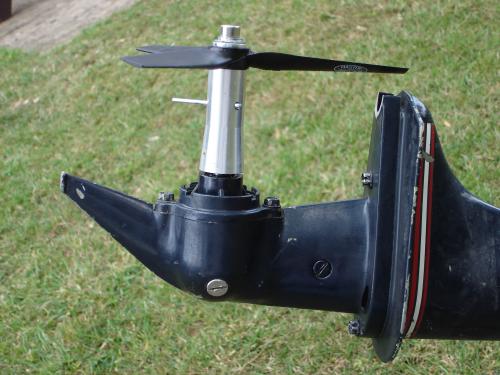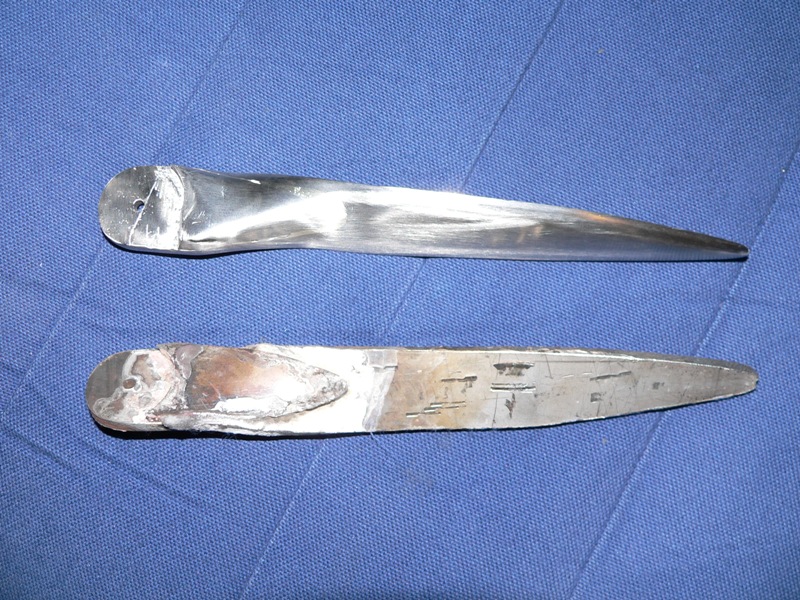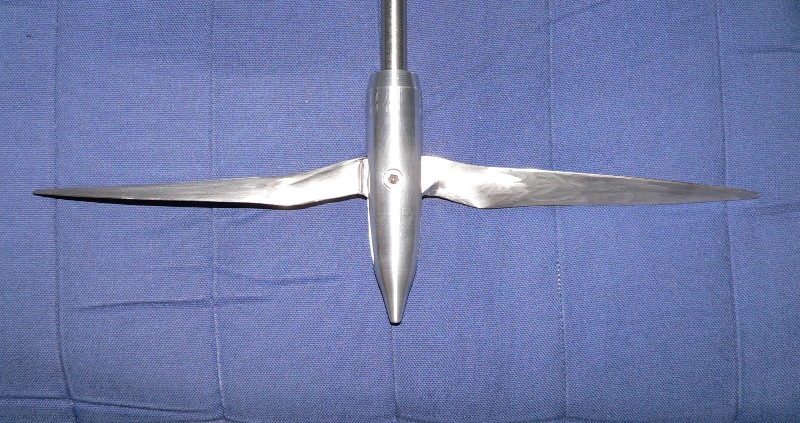electric outboard
|
|
Life is dull. Mowing. Shopping.
So I thought I'd show my electric outboard which I use on a little grp boat on holidays. The boat has home built teak floorboards which is my justification for being on this forum. The donor outboard is an Evinrude twin cylinder 3hp.  The brushless motor is Chinese made for the r/c 'planes hobby and all machining was done at my previous place of work. The adapter plate is extended so that a remote steering system could be used but so far I just tape a piece of wood to the original tiller as an extension. The white disc is an adapter for a cover which is almost as ugly as no cover at all. The controller (not shown) is in a diecast box and is also r/c hobby grade.  Normally the original prop is used but this was an attempt to increase efficiency. It was much more efficient than the original but collected so much weed so quickly that it was not practical.  At 350w the blades of this prop were bending far enough to hit the outboard leg. |
|
|
Neat conversion, Alan.
Making stainless steel prop blades isn't anything like as hard as it might seem, and doesn't need anything other than hand tools (although a small angle grinder and a drill with a flap disc makes life a bit easier). My first blade took me about an hour and half to make; now I can make a blade in about 40 mins. The process is fairly straightforward, if a little bit manual. I'm sure that stainless blades would get around your flexing problem, and if you included a hinge for them to fold, then you'd fix your weed fouling problem, albeit at the expense of losing effective astern propulsion. |
|
|
In reply to this post by Alan
Alan,
That's a nice bit of kit. On MilliBee I use a cheap and cheerful trolling motor on speed 5 (direct, no resistors), the original plastic prop and a 24V 350W ebike controller which limits at 28A. I did the whole 61 mile Thames Raid with that setup including several miles straight into a headwind gusting 24 mph, only 2 overnight charges and at least 32 miles on one charge of the 2 batteries, aided by the mother of all solar panels! The only minor problem is the controller got a bit hot tucked away in a locker - I plan to bolt it to a aluminium plate for cooling. It will be interesting to compare your conversion with my trolling motor sometime. cheers Paul |
|
|
On 14 Jun 2012 at 12:22, adminHBBR [via UK HBBR Forum] wrote:
> > > Alan, > > That's a nice bit of kit. On MilliBee I use a cheap and cheerful > trolling motor on speed 5 (direct, no resistors), the original plastic > prop and a 24V 350W ebike controller which limits at 28A. > > I did the whole 61 mile Thames Raid with that setup including several > miles straight into a headwind gusting 24 mph, only 2 overnight > charges and at least 32 miles on one charge of the 2 batteries, aided > by the mother of all solar panels! And a considerable water flow on the river. -- Hoping for calm nights Alastair Law, Yeovil, England. <http://www.little.jim.freeuk.com> |
|
|
I'd love to compare motors one day Paul. I'm now very hopeful that I can have a little electric boat from which I never have to bring the batteries ashore for charging, by using a solar panel.
The outboard does not have reverse because there is a wrap spring clutch in the leg which gives the neutral function; It might be a winter project to disable this function by pinning the two shaft halves together. Jeremy's encouragement means I might also have a go at making a folding prop - some pillar drill engineering is called for. |
|
|
If you want details of making stainless props, then this article by Rick Willoughby was my starting point: http://www.recumbents.com/wisil/hpb/Prop_Fabrication/Propfab.htm . This was written before he came up with the idea of making the blades fold to shed weed, but you can get a good idea of the technique used to make the blades.
Both Rick and I use Javaprop to get the design right first (http://www.mh-aerotools.de/airfoils/javaprop.htm), an application written originally for designing model aircraft props but which works well for water props if the density, speed of sound and kinematic viscosity figures are changed to those for water. |
|
|
Jeremy, That guide is excellent, except for one minor detail. I haven't a clue how to weld stainless! -Paul |
|
|
No need for welding, Paul, for the folding type, and I have no means of welding stainless, either. I use the same basic blade making method, but arrange for the blades to overlap in the hub where they hinge. To achieve this I just silver solder a thickening bit of stainless steel at the root end of each blade, using an ordinary cheap gas blowtorch (one I use for plumbing, came from B&Q I think). The photos below show a pair of blades, one in the rough, unshaped, form, with the extra bit silver soldered on, one partly finished. The second picture shows the completed prop blades with a pin going through the hinge point (this is at 90 deg to the drive shaft). The last picture is the finished prop.   
|
|
|
Folding Props
The idea of using folding props. to shed weed, I think was dreamed up by Cedric Lynch and shown at the Beale Park Boat show about 5 or 6 years ago on his record creating solar canoe. I recommended the idea to Rick Willoughby who had problems with weeds in the Murray Marathon. Fabrication If you used 3 mm thick strip you do not need to thicken this up with any brazing, also the blades do not need any shaping in the plan view, Rick recommends just a simple tip radius but I use a 30 degree angle at the tip. |
|
|
Depends on the prop loading, Dennis. The stress at the root was over the yield stress for 316 stainless with just a single thickness of 3.2 mm thick sheet on mine, bearing in mind that I'm running several times more power through it than a pedaller, as Alan would be with his RC motor driven outboard, or even Paul's modded trolling motor (which will run at a few hundred watts). Adding the thickening piece brought the stress back within acceptable limits for my prop and also made the blade more torsionally rigid, so making it less likely to de-pitch under load, which would have increased the apparent slip ratio. I could have increased the width of the blade at the root to get the stiffness back and reduce the max stress, but it seemed simpler to just add thickness, as this also gave the tiny advantage of allowing a better root shape to be achieved and allowed the hub to be made smaller in diameter with tight blade fold. I strongly suspect that one of the problems people experience with model aircraft props running at higher than expected slip ratios when used on boats is caused by the true pitch reducing under load from a lack of torsional stiffness in the blades, particularly the highly loaded root section. Model aircraft props are designed to work in a far less dense fluid, with a much lower blade loading, and in all probability are too flexible for use at high'ish power levels in a boat. It's also a problem that's been seen on quite a few aircraft props, and in that case has not only reduced performance but has also resulted in early blade failure. |
|
|
Jeremy
I think you are right, my blades are 32 wide and constant cord. If the thickness for a Clark Y section is .128% of cord then the blade should have been 4 thick but were only 3. However these showed no sign of bending in my CCC test trials and were only from MS strip. I did note that Rick Willoughby had problems on the first of his carbon fiber blades as they broke at the hub when subjected to higher power loads. |
|
|
Hello chaps, I'm in Brazil at the moment so not too much time for the forum but interesting comments about propellers.
I chose Graupner props for IC engines for the 2011 CCC because they are very stiff and strong. I should think most people making pedal boats are using APC props for electric only model use which are far weaker. I'm guessing that, in air, at higher rpm there is sufficient centrifugal force to keep the blades straight even at high powers. The Master Airscrew shown in the pictures above started as a larger diameter and was cut down specifically to end up with a prop with a strong thick root but it was still not up to the job. If I make a folder I am going to try carbon reinforced model aircraft folding blades, again cut down in diameter to retain a strong root, even though in theory some efficiency might be lost. I've done this with model planes with no noticeable ill effect. You might like to know that I am being pampered by family, vastly overfed and pleasantly warm. |
|
|
AFAIK, the electric APC props aren't much good for pedal boat use as they are a bit thin. Most of the photos I've seen of model props on boats have been the ordinary, fairly thick section, APC props.
I've been refining my electric outboard (based on the leg I used at Beale) and have managed to add a small µcontroller to the outrunner motor power head to do a couple of things. It intercepts the throttle signal and so allows an ordinary pot to be used as the speed control (the ebike controllers use a 1V to 3.5 V throttle signal or thereabouts, rather than a 0 V to 5 V signal) and it also uses a Hall effect shaft position sensor that tells it the prop position. This means that when I turn the power off the prop always stops pointing up and down, so it'll retract into a narrow outboard well easily. I'll bring the alternative power head with me to Henley, and, if conditions allow, see if I can try it out. I can swap between the cordless drill power head and the new one in a couple of minutes. |
«
Return to General Discussion
|
1 view|%1 views
| Free forum by Nabble | Edit this page |

